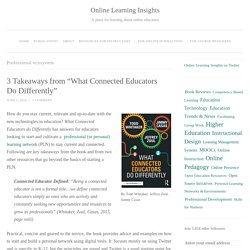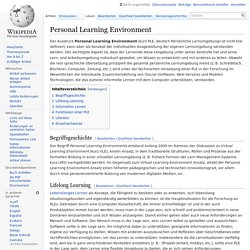

The Professional Ecosystem (Jane Hart) “Each of us is the center of the universe.

So is everyone else.” e e cummings In my previous post I looked at the individual’s perspective of workplace learning and included a graphic showing how individuals learn at and for work in 10 main ways. Essentially, I was describing a Professional Ecosystem (PES) – a set of organisational and personal, interconnecting and interacting elements – content, people, software, services, apps, etc – that helps an individual do their jobsolve performance problemscommunicate and collaborate with othersself-improve (for their existing work and/or future career), as well askeep up to date with what is happening in their industry or profession so that they remain relevant and marketable. The graphic above is an example of the tools and services an individual might make use of as part of his/her PES. A PES is therefore all of the following, but much more than any of them individually: So why do individuals need a PES?
So how do PESs fit into organisations? Professional ecosystem. How do you stay current, relevant and up-to-date with the new technologies in education?

What Connected Educators do Differently has answers for educators looking to start and cultivate a professional (or personal) learning network (PLN) to stay current and connected. Following are key takeaways from the book and from two other resources that go beyond the basics of starting a PLN. Connected Educator Defined: “Being a connected educator is not a formal title…we define connected educators simply as ones who are activity and constantly seeking new opportunities and resources to grow as professionals” (Whitaker, Zoul, Casas, 2015, page xxiii) Practical, concise and geared to the novice, the book provides advice and examples on how to start and build a personal network using digital tools. It focuses mostly on using Twitter and is specific to K-12, but the principles are sound and Twitter is a good starting point for learning how to connect and build a network. 1. 2. 3.
References. Importance of a PLN in Education (includes PLE) by Kelsey Rogers. PLE (example) Ein persönliches Lern-Netzwerk aufbauen (PLN) Personal Learning Environment. Der Ausdruck Personal Learning Environment (kurz PLE, deutsch Persönliche Lernumgebung) ist nicht klar definiert, kann aber als Konzept der individuellen Ausgestaltung der eigenen Lernumgebung verstanden werden.

Der wichtigste Aspekt ist, dass der Lernende diese Umgebung unter seiner Kontrolle hat und seine Lern- und Arbeitsumgebung individuell gestaltet, um Wissen zu entwickeln und mit anderen zu teilen. Obwohl die rein sprachliche Übersetzung prinzipiell die gesamte persönliche Lernumgebung meint (z. B. Schreibtisch, Bücherei, Computer, Zeitung, etc.), wird unter der technischen Umsetzung einer PLE in der Forschung im Wesentlichen die individuelle Zusammenstellung von (Social-)Software, Web-Services und Mobilen Technologien, die das zumeist informelle Lernen mit dem Computer unterstützen, verstanden. Begriffsgeschichte[Bearbeiten | Quelltext bearbeiten] Lifelong Learning[Bearbeiten | Quelltext bearbeiten] Informelles Lernen[Bearbeiten | Quelltext bearbeiten] The Networked Teacher. The Networked Teacher - Build your own PLN (Michelle Harvey) The Networked Student (Wendy Drexler)